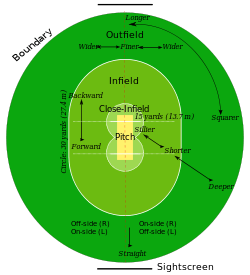Cricket field
 A standard cricket ground, showing the cricket pitch (brown), close-infield (light green) within 15 yards (13.7 m) of the striking batsman, infield (medium green) inside the white k;yard (27.4 m) circle, and outfield (dark green), with sight screens beyond the boundary at either end. |
 A perspective view of the cricket pitch from the bowler's end. The bowler runs in past one side of the wicket at the bowler's end, either 'over' the wicket or 'round' the wicket. |
 The Cricket pitch dimensions |
A cricket field consists of a large grassy ground on which the game of cricket is played; this is ostensibly an oval though most cricket grounds would more accurately be described either as a convex set or as a convex polygon with an infinite number of sides. Cricket grounds can be almost perfectly circular, elongated ovals or entirely irregular shapes with little or no symmetry – but they will have entirely curved boundaries, almost without exception. There are no fixed dimensions for the field but its diameter usually varies between 450 feet (137 m) and 500 feet (150 m). Cricket is unusual among major sports (along with Golf, Australian rules football and baseball) in that there is no official rule for a fixed-shape ground for professional games. On most grounds, a rope demarcates the perimeter of the field and is known as the boundary. Within the boundary and generally as close to the centre as possible will be the square which is an area of carefully prepared grass upon which cricket pitches can be prepared and marked for matches.
The ICC Standard Playing Conditions define the minimum and maximum size of the playing surface for international matches. Law 19.1 of ICC Test match Playing Conditions states:
"The playing area shall be a minimum of 150 yards (137.16 metres) from boundary to boundary square of the pitch, with the shorter of the two square boundaries being a minimum 65 yards (59.43 metres). The straight boundary at both ends of the pitch shall be a minimum of 70 yards (64.00 metres), measured from the centre of the pitch to be used. In all cases the aim shall be to provide the largest playing area, subject to no boundary exceeding 90 yards (82.29 meters) from the centre of the pitch to be used. "[1]
In addition, the conditions require a minimum three-yard gap between the "rope" and the surrounding fencing or advertising boards. This allow players to dive without risk of injury.
The conditions contain a grandfather clause, which exempts stadiums built before October 2007. However, most stadiums which regularly host international games easily meet the minimum dimensions.
It is worth noting that based on these guidelines, a cricket field must have at least 6,000 square yards ((150+3+3)/2*(70+70+3+3-22/2)/2*pi) of grass area. A more realistic Test match stadium would have more than 9000 square yards of grass (having a straight boundary of about 80m).[2] In contrast an association football field needs only about 20,000 square yards of grass, and an Olympic stadium would contain 8350 square yards of grass within its 400m running track, making it impossible to play international cricket matches unless the stadium was specifically built for cricket. Nevertheless, Stadium Australia which hosted the Sydney Olympics in 2000 had its running track turfed over with 30,000 seats removed to make it possible to play cricket there, at a cost of A$80 million.[3] This is one of the reasons cricket games generally cannot be hosted outside the traditional cricket-playing countries, and a few non-Test nations like Canada, the UAE and Kenya that have built Test standard stadiums.
The pitch
Most of the action takes place in the centre of this ground, on a rectangular clay strip usually with short grass called the pitch. The pitch measures 22 yards (20 m) long.
At each end of the pitch three upright wooden stakes, called the stumps, are hammered into the ground. Two wooden crosspieces, known as the bails, sit in grooves atop the stumps, linking each to its neighbour. Each set of three stumps and two bails is collectively known as a wicket. One end of the pitch is designated the batting end where the batsman stands and the other is designated the bowling end where the bowler runs in to bowl. The area of the field on the side of the line joining the wickets where the batsman holds his bat (the right-hand side for a right-handed batsman, the left for a left-hander) is known as the off side, the other as the leg side or on side.
Lines drawn or painted on the pitch are known as creases. Creases are used to adjudicate the dismissals of batsmen and to determine whether a delivery is fair.
Parts of the field
For a one-innings match played over a set number of fair deliveries, there are two additional field markings. A painted oval is made by drawing a semicircle of 30 yards (27.4 m) radius from the centre of each wicket with respect to the breadth of the pitch and joining them with lines parallel, 30 yards (27.4 m) to the length of the pitch. This line, commonly known as the circle, divides the field into an infield and outfield. Two circles of radius 15 yards (13.7 m), centred at middle stump guard on the popping crease and often marked by dots, define the close-infield. The infield, outfield, and the close-infield are used to enforce fielding restrictions.
See also
References
- ↑ http://static.icc-cricket.yahoo.net/ugc/documents/DOC_1F113528040177329F4B40FE47C77AE2_1254317595929_824.pdf
- ↑ http://vip-flags.com/largestflag_vip.htm A flag measuring 340ft x 510ft i.e. 173,400 sq.ft (19,266 sq. yds) was unveiled at the National Stadium, Karachi. This video <https://www.youtube.com/watch?v=xfbOUUYohxc> shows that the rectangular flag, when fully unfurled, comfortably fit within the playing area.
- ↑ "CSA rules out cricket at FIFA World Cup venues | Cricket | ESPN Cricinfo". Cricinfo.com. Retrieved 3 January 2016.